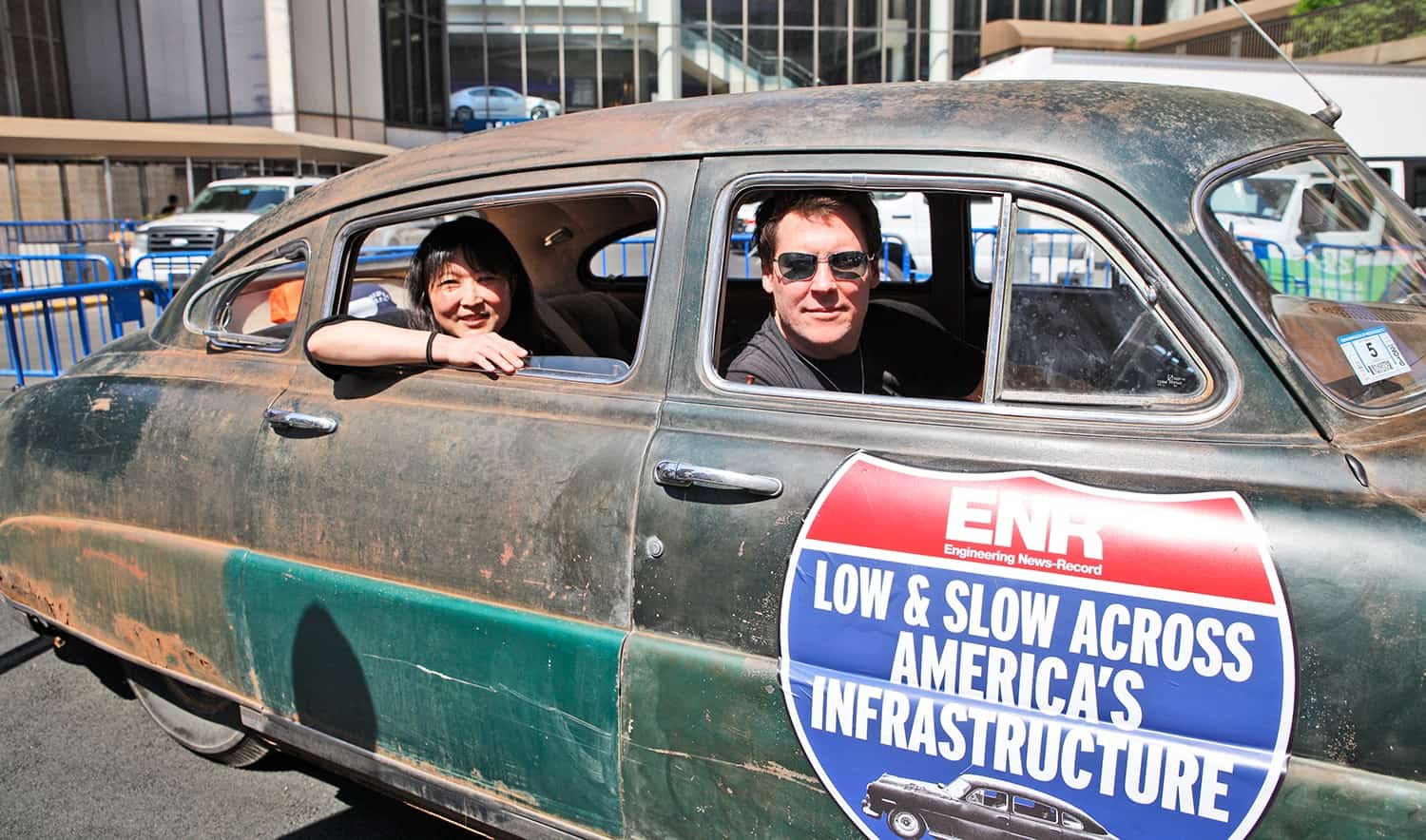
To draw attention to the state of the American infrastructure, including its highways and bridges, Engineering News-Record has sent two reporters and a 65-year-old Hudson on a cross-country trip.
“Low and Slow Across America’s Infrastructure” is the name given to the assignment, which involves ENR.com senior transportation editor Aileen Cho and author Dan McNichol in a 1949 Hudson Commodore they call “Mrs. Martin” after the car’s original and only previous owner.

ENR.com, which supplies information to construction-industry professionals and traces its roots to print publications dating to 1874, selected a vintage vehicle because it “symbolizes the age of the Interstate — and the effort it requires to keep it running,” according to a news release.
“By it visiting megaprojects like the Ohio River Bridges, Appalachian public works garages, or engineering offices using the latest and greatest in high-tech tools for asset maintenance, Dan and Aileen aim to dig out the stories of the efforts by public servants and private industry to keep our aging roads, mass transit systems, airports, and water systems intact, prudently upgraded or wisely replaced, in an age of perpetual procrastination regarding federal funding,” the news release says.
The trip began May 14 at West Point, New York, and runs through June 13 to Los Angeles. Stops along the way include Philadelphia, Washington DC, Louisville, St. Louis, Kansas City, Denver, Salt Lake City, Reno, Sacramento, San Francisco and Fresno.
Low and Slow has been slow in developing. McNichol, author of books on the Interstate highway system and Boston’s “Big Dig,” purchased the Hudson in 2011 for $2,500 through an on-line auction site and then worked with Dr. Per Christiansen for two years to get the car back to running order. The car, which McNichol has driven on a full 14,000-mile lap of the United States on an earlier infrastructure study, was featured in a segment of the Driving America special Monday night on the National Geographic Channel.
“Our Hudson is as old, rusty and energy-defunct as America’s infrastructure,” McNichol wrote in a blog on ENR.com.
“The lights dim when the horn is honked,” he continued. “When accelerating uphill in the rain, the wipers stall. The Hudson has half the power, or half the electricity, needed: 100 horses and 6 volts.

“U.S. roads, bridges and transit systems are as aged as the Hudson. Our drinking-water facilities, schools and dams are as challenged by everyday uses as the Hudson’s systems will be on our cross-country road trip. As the car mirrors what America’s vital systems are looking like today, Cho and I are method-acting the part of America’s failing infrastructure.”
McNichol also noted that the ’49 Hudson Commodore is the same model Jack Kerouac used for his On the Road road trip and also was the model used in the movie Driving Mrs. Daisy.
“It’s time for a new ride: infrastructure that’s needed for us and our future generations to succeed,” he added.
Here is the remaining schedule for the Low and Slow tour:
May 27-28: Kansas City (visit streetcar project)
May 28: Kansas City to Denver
June 1-2: Denver (visit Fastracks and other local projects)
June 2-3: Denver to Glenwood Springs (visit I-70 project)
June 4-6: Glenwood Springs to Salt Lake City
June 8-9: Salt Lake City to Reno, Nev.
June 9-10: Reno to Sacramento, Calif.
June 10-11: Sacramento to San Francisco
June 11: Sacramento to Fresno (visit California high-speed rail project)
June 12-13: Fresno to Los Angeles






What happened to all the cash for those “shovel ready jobs” to repair Americas’ infastructure that was spent? Driving down Route 66 this last week, you see the signs posted… construction next 10 miles, cost 15 million dollars. Does it really cost that much to put down asphalt? If so, I’m in the wrong business.
…..Ryan, maybe you should do a little research….it might answer your questions. Repairing a 10 mile stretch of highway takes a lot more than just laying down “some asphalt”. That may not fully explain YOUR quoted $15 Million but then I didn’t read the sign nor know ALL the details….that’s what the research would explain. BTW Ryan while you’ve over simplified….have you priced the equipment needed to “redo a highway” lately AND the wages that go with it? The wages are not minimum wage either. I take it you’ve never worked a summer road crew several summers in a row to help pay for and get through college.
I was on I-70 in Kansas today, heading east, and I saw the ’49 Hudson heading west!
I Agree ! Were are the shovel Ready Jobs as promised…. Ever hear of CCC